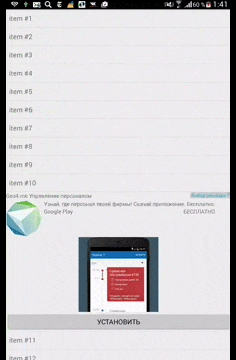I'm trying to implement native ads in my android application. But I want to do it using admob only. I searched a lot for solution but could not find exact one to do so.
I know it is possible using MoPub.
What I wanted to do is this:
Show ads inside list item which means one of the ListView/RecyclerView item can be one ad like below image.
I found some links and references but that doesn't explain proper implementation of the native ads.
Link 1 : Native ads overview
Link 2 : DFP Android Guides > Targeting
Link 3 : DFP Quick Start Guide
If it is not possible to do it using admob, MoPub is best solution for me right now.
Any help and guidance would be helpful. thanks.
Add this code to your Listview Adapter
builder.forAppInstallAd(new NativeAppInstallAd.OnAppInstallAdLoadedListener() {
@Override
public void onAppInstallAdLoaded(NativeAppInstallAd ad) {
FrameLayout frameLayout =
(FrameLayout) findViewById(R.id.fl_adplaceholder);
NativeAppInstallAdView adView = (NativeAppInstallAdView) getLayoutInflater()
.inflate(R.layout.ad_app_install, null);
populateAppInstallAdView(ad, adView);
frameLayout.removeAllViews();
frameLayout.addView(adView);
}
});
AdLoader adLoader = builder.withAdListener(new AdListener() {
@Override
public void onAdFailedToLoad(int errorCode) {
Toast.makeText(MainActivity.this, "Failed to load native ad: "
+ errorCode, Toast.LENGTH_SHORT).show();
}
}).build();
adLoader.loadAd(new AdRequest.Builder().build());
Make some changes for listview Adapter and you will get populateAppInstallAdView() method from below link
Everything is covered in this example please go through this https://github.com/googleads/googleads-mobile-android-examples/tree/master/admob
Recently I stucked with the same question. Then I decided to post my solution for that to admobadapter. Hope it will help you.
The basic usage could look like:
ListView lvMessages;
AdmobAdapterWrapper adapterWrapper;
@Override
public void onCreate(Bundle savedInstanceState) {
super.onCreate(savedInstanceState);
setContentView(R.layout.activity_main);
initListViewItems();
}
/**
* Inits an adapter with items, wrapping your adapter with a {@link AdmobAdapterWrapper} and setting the listview to this wrapper
* FIRST OF ALL Please notice that the following code will work on a real devices but emulator!
*/
private void initListViewItems() {
lvMessages = (ListView) findViewById(R.id.lvMessages);
//creating your adapter, it could be a custom adapter as well
ArrayAdapter<String> adapter = new ArrayAdapter<String>(this,
android.R.layout.simple_list_item_1);
adapterWrapper = new AdmobAdapterWrapper(this);
adapterWrapper.setAdapter(adapter); //wrapping your adapter with a AdmobAdapterWrapper.
//here you can use the following string to set your custom layouts for a different types of native ads
//adapterWrapper.setInstallAdsLayoutId(R.layout.your_installad_layout);
//adapterWrapper.setcontentAdsLayoutId(R.layout.your_installad_layout);
//Sets the max count of ad blocks per dataset, by default it equals to 3 (according to the Admob's policies and rules)
adapterWrapper.setLimitOfAds(3);
//Sets the number of your data items between ad blocks, by default it equals to 10.
//You should set it according to the Admob's policies and rules which says not to
//display more than one ad block at the visible part of the screen,
// so you should choose this parameter carefully and according to your item's height and screen resolution of a target devices
adapterWrapper.setNoOfDataBetweenAds(10);
//It's a test admob ID. Please replace it with a real one only when you will be ready to deploy your product to the Release!
//Otherwise your Admob account could be banned
//String admobUnitId = getResources().getString(R.string.banner_admob_unit_id);
//adapterWrapper.setAdmobReleaseUnitId(admobUnitId);
lvMessages.setAdapter(adapterWrapper); // setting an AdmobAdapterWrapper to a ListView
//preparing the collection of data
final String sItem = "item #";
ArrayList<String> lst = new ArrayList<String>(100);
for(int i=1;i<=100;i++)
lst.add(sItem.concat(Integer.toString(i)));
//adding a collection of data to your adapter and rising the data set changed event
adapter.addAll(lst);
adapter.notifyDataSetChanged();
}
And the result will look like the following

Native ads are included in Google Play Services along with the rest of DFP/AdMob advertising. Make sure you have the following listed as dependencies in your build.gradle (note that 7.5.0 is the highest version as of this posting).
compile "com.google.android.gms:play-services-base:7.5.0"
compile "com.google.android.gms:play-services-ads:7.5.0"
Then you can display native ads
AdLoader adLoader = new AdLoader.Builder(context, "/6499/example/native")
.forAppInstallAd(new OnAppInstallAdLoadedListener() {
@Override
public void onAppInstallAdLoaded(NativeAppInstallAd appInstallAd) {
// Show the app install ad.
}
})
.forContentAd(new OnContentAdLoadedListener() {
@Override
public void onContentAdLoaded(NativeContentAd contentAd) {
// Show the content ad.
}
})
.withAdListener(new AdListener() {
@Override
public void onAdFailedToLoad(int errorCode) {
// Handle the failure by logging, altering the UI, etc.
}
})
.withNativeAdOptions(new NativeAdOptions.Builder()
// Methods in the NativeAdOptions.Builder class can be
// used here to specify individual options settings.
.build())
.build();
Click here for complete documentation.
If you love us? You can donate to us via Paypal or buy me a coffee so we can maintain and grow! Thank you!
Donate Us With